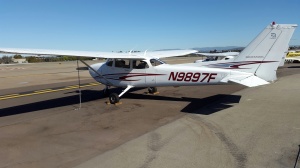 I had another lesson this afternoon at Pinnacle Aviation Academy. In this lesson, I began work on air traffic control communications and also stalls. The stalls were really scary for me and I was sweating out of fear/nervousness and the combination of fear and also the falling sensation from the stalls almost made me sick. There was no puke bag on the airplane and I didn’t want to vomit 5,000 feet above some poor little kid walking home from school, so somehow I overcame my nausea and recovered. Although I was very, very glad once the plane was on the ground and safely in its parking spot.
I had another lesson this afternoon at Pinnacle Aviation Academy. In this lesson, I began work on air traffic control communications and also stalls. The stalls were really scary for me and I was sweating out of fear/nervousness and the combination of fear and also the falling sensation from the stalls almost made me sick. There was no puke bag on the airplane and I didn’t want to vomit 5,000 feet above some poor little kid walking home from school, so somehow I overcame my nausea and recovered. Although I was very, very glad once the plane was on the ground and safely in its parking spot.
Why We Learn Stalls
As I learned in my lessons and was reminded today, are three reasons student pilots need to learn stalls:
- We need to learn how to recognize an approaching or accidental stall by sight, sound, and feel;
- We need to know the necessary corrective action to recover from a stall; and
- We need to know what to do to avoid getting into a stalled condition accidentally.
You can do power off stalls and power on stalls. Today we worked on power off stalls, which simulate a stall during the final approach to landing. During your stall recovery, your goal should be to use as little altitude as possible. As soon as airspeed allows, you should smoothly pitch back up again. If a wing does drop, release back pressure on the control stick or wheel and use coordinated aileron and rudder to level the wings.
Stall Recovery
To recover from a stall, you need to do three things. First, you need to decrease the pitch altitude and angle of attack (pitch the aircraft to the horizon). Second, you need to apply maximum allowable power (push that throttle all the way in for full power). And third, you need to regain straight and level flight with coordinated use of all flight controls. To do this, you need to level the wings with the rudder only, retract the wing flaps, maintain a positive rate of climb, and level off at entry altitude.
Air Traffic Control Communications Guide
After I write down ATIS information on my kneeboard (ATIS info is on channel 120.15 at CRQ), I need to request permission to taxi. At CRQ, this goes something like this: “Palomar Ground Cessna November 9897 Foxtrot at Pinnacle Aviation Taxi to Runway 24 with Information (ATIS). Once I get the instruction and read it back, I taxi to the hold short line, do the run up checklist, and then radio the tower and request a departure. If we’re heading out to Valley Center to do maneuvers, I want to do a Right Downwind departure. I tune the radio to Tower 118.6 and request “Palomar Tower Cessna November 9897 Foxtrot Holding Short of Runway 24 Request a Right Downwind Departure”.
What I Need to Work On
I need to work on memorizing my procedures and also just practicing over and over. Everything seems to be easier the second and third time. And more fun, of course!


Leave a Reply